Psychological Effects of Marijuana Addiction: A Detailed Analysis
VerifiedAdded on 2022/08/23
|8
|1606
|15
Essay
AI Summary
This essay provides a comprehensive analysis of marijuana addiction from a psychological perspective. It begins by defining addiction and highlighting the short-term and long-term effects of cannabis use. The essay then delves into the relationship between marijuana and the dopamine neurotransmitter system, explaining how THC interacts with the brain's receptors. It explores the impact of marijuana on brain function, including its effects on pleasure centers and behavior control. The essay also outlines the stages of substance addiction, from initiation and experimentation to treatment, emphasizing the role of psychological theories like social psychology and behaviorism in understanding addiction. Finally, the essay concludes by summarizing the key findings and the importance of seeking treatment for substance dependence. The essay cites several research papers to support its arguments and provides a well-rounded overview of the topic.

HEALTH CARE 0
Psychology of Addiction
[Pick the date]
[Year]
Psychology of Addiction
[Pick the date]
[Year]
Paraphrase This Document
Need a fresh take? Get an instant paraphrase of this document with our AI Paraphraser
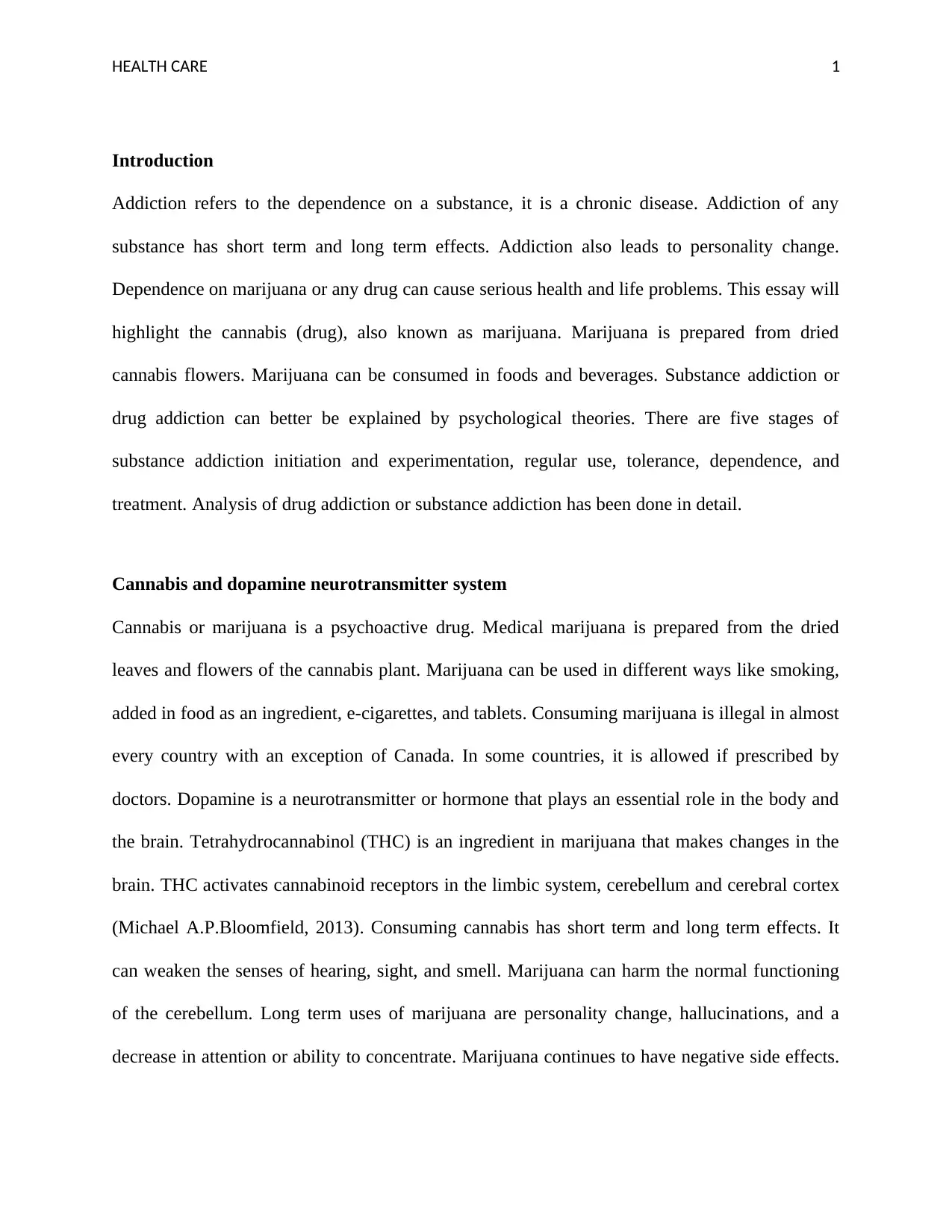
HEALTH CARE 1
Introduction
Addiction refers to the dependence on a substance, it is a chronic disease. Addiction of any
substance has short term and long term effects. Addiction also leads to personality change.
Dependence on marijuana or any drug can cause serious health and life problems. This essay will
highlight the cannabis (drug), also known as marijuana. Marijuana is prepared from dried
cannabis flowers. Marijuana can be consumed in foods and beverages. Substance addiction or
drug addiction can better be explained by psychological theories. There are five stages of
substance addiction initiation and experimentation, regular use, tolerance, dependence, and
treatment. Analysis of drug addiction or substance addiction has been done in detail.
Cannabis and dopamine neurotransmitter system
Cannabis or marijuana is a psychoactive drug. Medical marijuana is prepared from the dried
leaves and flowers of the cannabis plant. Marijuana can be used in different ways like smoking,
added in food as an ingredient, e-cigarettes, and tablets. Consuming marijuana is illegal in almost
every country with an exception of Canada. In some countries, it is allowed if prescribed by
doctors. Dopamine is a neurotransmitter or hormone that plays an essential role in the body and
the brain. Tetrahydrocannabinol (THC) is an ingredient in marijuana that makes changes in the
brain. THC activates cannabinoid receptors in the limbic system, cerebellum and cerebral cortex
(Michael A.P.Bloomfield, 2013). Consuming cannabis has short term and long term effects. It
can weaken the senses of hearing, sight, and smell. Marijuana can harm the normal functioning
of the cerebellum. Long term uses of marijuana are personality change, hallucinations, and a
decrease in attention or ability to concentrate. Marijuana continues to have negative side effects.
Introduction
Addiction refers to the dependence on a substance, it is a chronic disease. Addiction of any
substance has short term and long term effects. Addiction also leads to personality change.
Dependence on marijuana or any drug can cause serious health and life problems. This essay will
highlight the cannabis (drug), also known as marijuana. Marijuana is prepared from dried
cannabis flowers. Marijuana can be consumed in foods and beverages. Substance addiction or
drug addiction can better be explained by psychological theories. There are five stages of
substance addiction initiation and experimentation, regular use, tolerance, dependence, and
treatment. Analysis of drug addiction or substance addiction has been done in detail.
Cannabis and dopamine neurotransmitter system
Cannabis or marijuana is a psychoactive drug. Medical marijuana is prepared from the dried
leaves and flowers of the cannabis plant. Marijuana can be used in different ways like smoking,
added in food as an ingredient, e-cigarettes, and tablets. Consuming marijuana is illegal in almost
every country with an exception of Canada. In some countries, it is allowed if prescribed by
doctors. Dopamine is a neurotransmitter or hormone that plays an essential role in the body and
the brain. Tetrahydrocannabinol (THC) is an ingredient in marijuana that makes changes in the
brain. THC activates cannabinoid receptors in the limbic system, cerebellum and cerebral cortex
(Michael A.P.Bloomfield, 2013). Consuming cannabis has short term and long term effects. It
can weaken the senses of hearing, sight, and smell. Marijuana can harm the normal functioning
of the cerebellum. Long term uses of marijuana are personality change, hallucinations, and a
decrease in attention or ability to concentrate. Marijuana continues to have negative side effects.

HEALTH CARE 2
Studies have also found out that young people who used marijuana has low verbal IQ’s (Rubin,
2011).
Dopamine neurotransmitter system and marijuana
A normal brain reads word and brain through eyes convert it as information. To convey a
message a neurotransmitter sends the signal to neuron to a receiving nerve cell across space
known as the synapse. Dopamine functions as a paracrine messenger. When marijuana enters the
brain it causes neurotransmission to fluctuate dramatically. It functions as the neurotransmitter
of the brain. Chemical released by nerve cells give signals to other neurons. Drugs like marijuana
target cannabinoid receptor that are found in the brain and affects decision making and reward
processing (Vaidya, Block, & O'leary, 2012).
Marijuana effects on the brain
Marijuana affects the pleasure centres in the brain same as alcohol. As soon as it enters the brain,
the brain releases the chemical dopamine. Inhaling or smoking marijuana relaxes the muscles,
and immediate changes in mood (Hendrika H.van Hella, Vink, & Ossewaardec, 2010).
Marijuana use effects may vary from person to person. Marijuana directly affects normal
behaviour control of a human. In some cases, long term use of marijuana can create problems
like lower verbal IQ, trouble in concentrating, lower ability to coordinate with others, and
decreased interest in work. Smoking marijuana gives instant relaxation and euphoric feeling.
Because of instant results, people get addicted to marijuana or any other drugs (Francesca M.
Filbey, 2014). Drugs alter neurotransmission by interacting with molecular components of the
sending and receiving process other than receptors. Dramatic increase and decrease in the nerve
Studies have also found out that young people who used marijuana has low verbal IQ’s (Rubin,
2011).
Dopamine neurotransmitter system and marijuana
A normal brain reads word and brain through eyes convert it as information. To convey a
message a neurotransmitter sends the signal to neuron to a receiving nerve cell across space
known as the synapse. Dopamine functions as a paracrine messenger. When marijuana enters the
brain it causes neurotransmission to fluctuate dramatically. It functions as the neurotransmitter
of the brain. Chemical released by nerve cells give signals to other neurons. Drugs like marijuana
target cannabinoid receptor that are found in the brain and affects decision making and reward
processing (Vaidya, Block, & O'leary, 2012).
Marijuana effects on the brain
Marijuana affects the pleasure centres in the brain same as alcohol. As soon as it enters the brain,
the brain releases the chemical dopamine. Inhaling or smoking marijuana relaxes the muscles,
and immediate changes in mood (Hendrika H.van Hella, Vink, & Ossewaardec, 2010).
Marijuana use effects may vary from person to person. Marijuana directly affects normal
behaviour control of a human. In some cases, long term use of marijuana can create problems
like lower verbal IQ, trouble in concentrating, lower ability to coordinate with others, and
decreased interest in work. Smoking marijuana gives instant relaxation and euphoric feeling.
Because of instant results, people get addicted to marijuana or any other drugs (Francesca M.
Filbey, 2014). Drugs alter neurotransmission by interacting with molecular components of the
sending and receiving process other than receptors. Dramatic increase and decrease in the nerve
⊘ This is a preview!⊘
Do you want full access?
Subscribe today to unlock all pages.

Trusted by 1+ million students worldwide
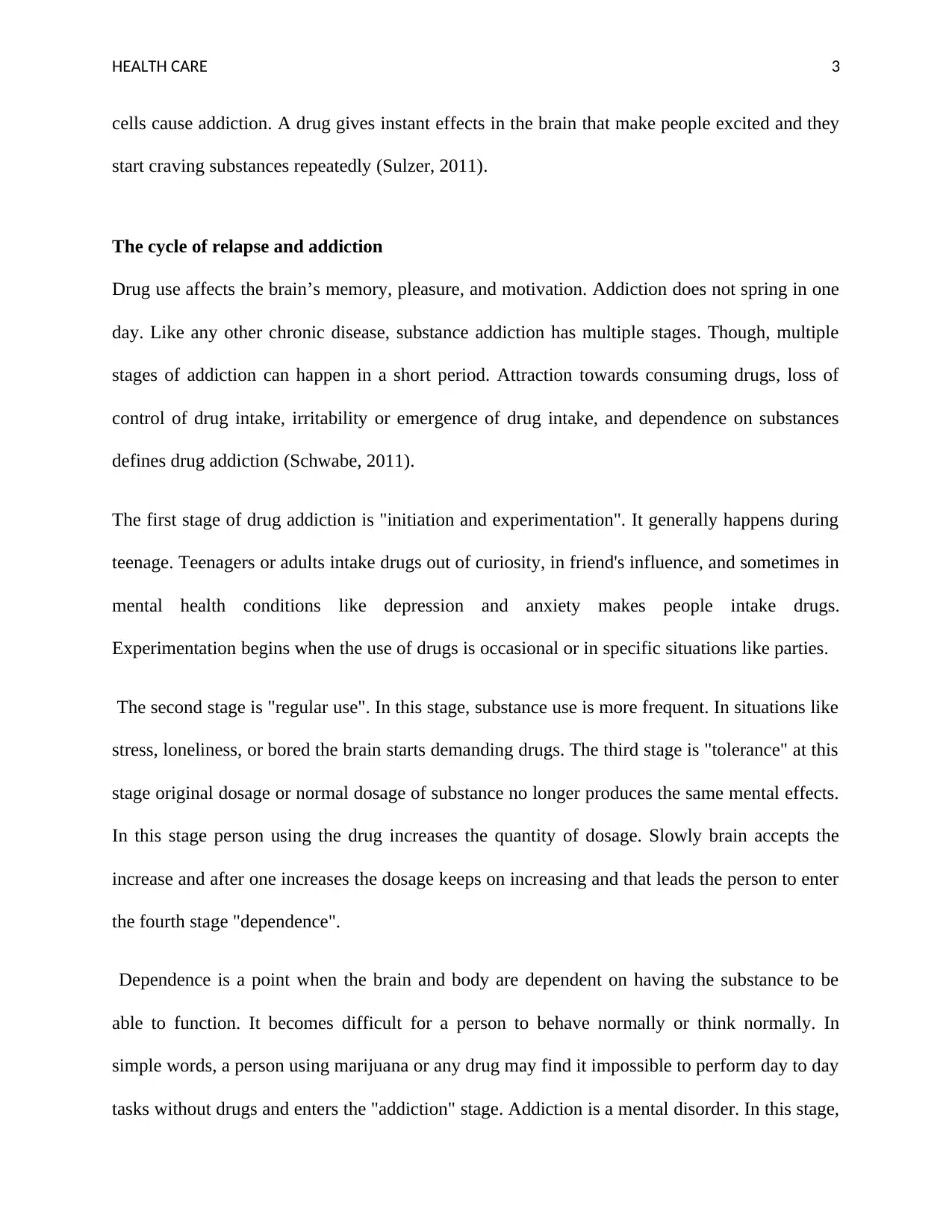
HEALTH CARE 3
cells cause addiction. A drug gives instant effects in the brain that make people excited and they
start craving substances repeatedly (Sulzer, 2011).
The cycle of relapse and addiction
Drug use affects the brain’s memory, pleasure, and motivation. Addiction does not spring in one
day. Like any other chronic disease, substance addiction has multiple stages. Though, multiple
stages of addiction can happen in a short period. Attraction towards consuming drugs, loss of
control of drug intake, irritability or emergence of drug intake, and dependence on substances
defines drug addiction (Schwabe, 2011).
The first stage of drug addiction is "initiation and experimentation". It generally happens during
teenage. Teenagers or adults intake drugs out of curiosity, in friend's influence, and sometimes in
mental health conditions like depression and anxiety makes people intake drugs.
Experimentation begins when the use of drugs is occasional or in specific situations like parties.
The second stage is "regular use". In this stage, substance use is more frequent. In situations like
stress, loneliness, or bored the brain starts demanding drugs. The third stage is "tolerance" at this
stage original dosage or normal dosage of substance no longer produces the same mental effects.
In this stage person using the drug increases the quantity of dosage. Slowly brain accepts the
increase and after one increases the dosage keeps on increasing and that leads the person to enter
the fourth stage "dependence".
Dependence is a point when the brain and body are dependent on having the substance to be
able to function. It becomes difficult for a person to behave normally or think normally. In
simple words, a person using marijuana or any drug may find it impossible to perform day to day
tasks without drugs and enters the "addiction" stage. Addiction is a mental disorder. In this stage,
cells cause addiction. A drug gives instant effects in the brain that make people excited and they
start craving substances repeatedly (Sulzer, 2011).
The cycle of relapse and addiction
Drug use affects the brain’s memory, pleasure, and motivation. Addiction does not spring in one
day. Like any other chronic disease, substance addiction has multiple stages. Though, multiple
stages of addiction can happen in a short period. Attraction towards consuming drugs, loss of
control of drug intake, irritability or emergence of drug intake, and dependence on substances
defines drug addiction (Schwabe, 2011).
The first stage of drug addiction is "initiation and experimentation". It generally happens during
teenage. Teenagers or adults intake drugs out of curiosity, in friend's influence, and sometimes in
mental health conditions like depression and anxiety makes people intake drugs.
Experimentation begins when the use of drugs is occasional or in specific situations like parties.
The second stage is "regular use". In this stage, substance use is more frequent. In situations like
stress, loneliness, or bored the brain starts demanding drugs. The third stage is "tolerance" at this
stage original dosage or normal dosage of substance no longer produces the same mental effects.
In this stage person using the drug increases the quantity of dosage. Slowly brain accepts the
increase and after one increases the dosage keeps on increasing and that leads the person to enter
the fourth stage "dependence".
Dependence is a point when the brain and body are dependent on having the substance to be
able to function. It becomes difficult for a person to behave normally or think normally. In
simple words, a person using marijuana or any drug may find it impossible to perform day to day
tasks without drugs and enters the "addiction" stage. Addiction is a mental disorder. In this stage,
Paraphrase This Document
Need a fresh take? Get an instant paraphrase of this document with our AI Paraphraser
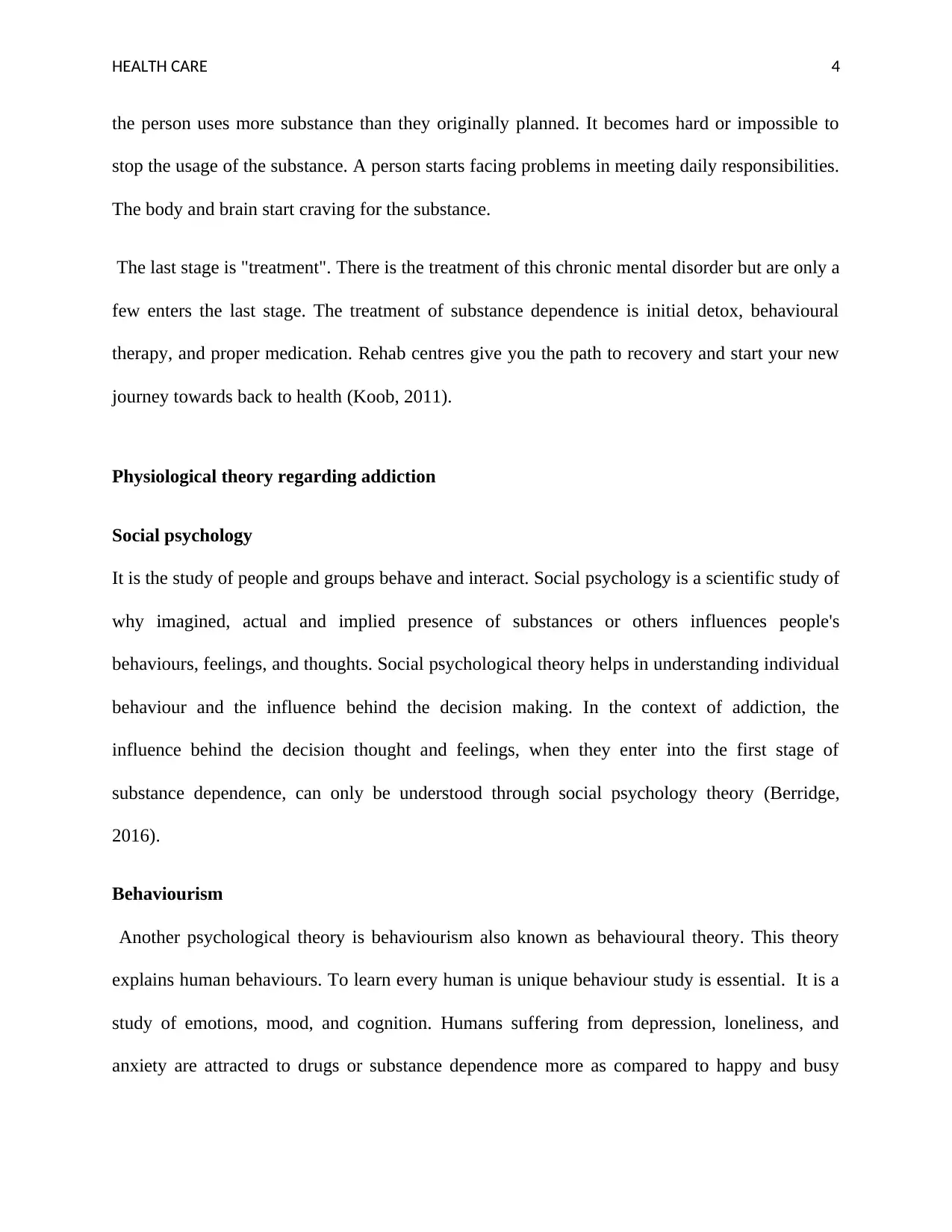
HEALTH CARE 4
the person uses more substance than they originally planned. It becomes hard or impossible to
stop the usage of the substance. A person starts facing problems in meeting daily responsibilities.
The body and brain start craving for the substance.
The last stage is "treatment". There is the treatment of this chronic mental disorder but are only a
few enters the last stage. The treatment of substance dependence is initial detox, behavioural
therapy, and proper medication. Rehab centres give you the path to recovery and start your new
journey towards back to health (Koob, 2011).
Physiological theory regarding addiction
Social psychology
It is the study of people and groups behave and interact. Social psychology is a scientific study of
why imagined, actual and implied presence of substances or others influences people's
behaviours, feelings, and thoughts. Social psychological theory helps in understanding individual
behaviour and the influence behind the decision making. In the context of addiction, the
influence behind the decision thought and feelings, when they enter into the first stage of
substance dependence, can only be understood through social psychology theory (Berridge,
2016).
Behaviourism
Another psychological theory is behaviourism also known as behavioural theory. This theory
explains human behaviours. To learn every human is unique behaviour study is essential. It is a
study of emotions, mood, and cognition. Humans suffering from depression, loneliness, and
anxiety are attracted to drugs or substance dependence more as compared to happy and busy
the person uses more substance than they originally planned. It becomes hard or impossible to
stop the usage of the substance. A person starts facing problems in meeting daily responsibilities.
The body and brain start craving for the substance.
The last stage is "treatment". There is the treatment of this chronic mental disorder but are only a
few enters the last stage. The treatment of substance dependence is initial detox, behavioural
therapy, and proper medication. Rehab centres give you the path to recovery and start your new
journey towards back to health (Koob, 2011).
Physiological theory regarding addiction
Social psychology
It is the study of people and groups behave and interact. Social psychology is a scientific study of
why imagined, actual and implied presence of substances or others influences people's
behaviours, feelings, and thoughts. Social psychological theory helps in understanding individual
behaviour and the influence behind the decision making. In the context of addiction, the
influence behind the decision thought and feelings, when they enter into the first stage of
substance dependence, can only be understood through social psychology theory (Berridge,
2016).
Behaviourism
Another psychological theory is behaviourism also known as behavioural theory. This theory
explains human behaviours. To learn every human is unique behaviour study is essential. It is a
study of emotions, mood, and cognition. Humans suffering from depression, loneliness, and
anxiety are attracted to drugs or substance dependence more as compared to happy and busy
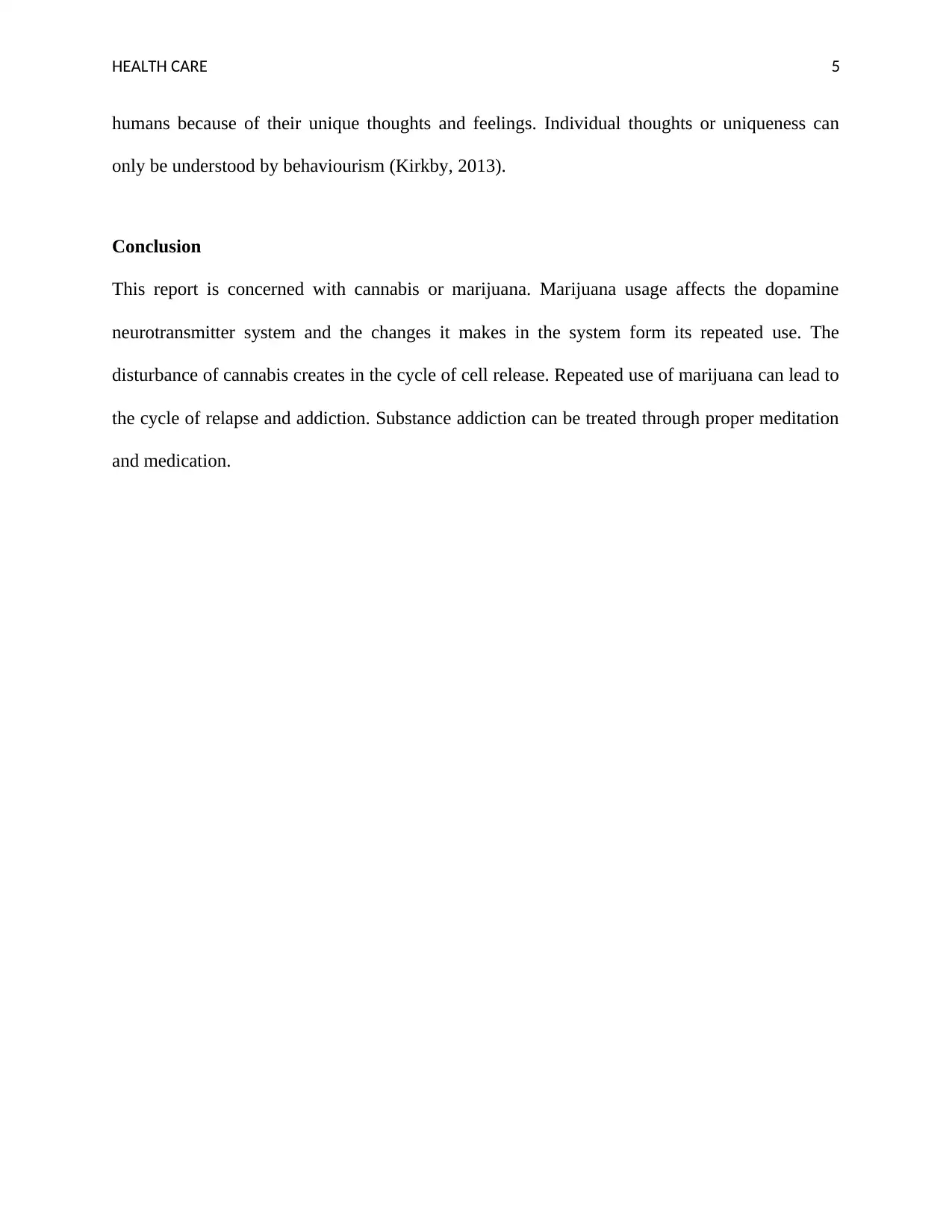
HEALTH CARE 5
humans because of their unique thoughts and feelings. Individual thoughts or uniqueness can
only be understood by behaviourism (Kirkby, 2013).
Conclusion
This report is concerned with cannabis or marijuana. Marijuana usage affects the dopamine
neurotransmitter system and the changes it makes in the system form its repeated use. The
disturbance of cannabis creates in the cycle of cell release. Repeated use of marijuana can lead to
the cycle of relapse and addiction. Substance addiction can be treated through proper meditation
and medication.
humans because of their unique thoughts and feelings. Individual thoughts or uniqueness can
only be understood by behaviourism (Kirkby, 2013).
Conclusion
This report is concerned with cannabis or marijuana. Marijuana usage affects the dopamine
neurotransmitter system and the changes it makes in the system form its repeated use. The
disturbance of cannabis creates in the cycle of cell release. Repeated use of marijuana can lead to
the cycle of relapse and addiction. Substance addiction can be treated through proper meditation
and medication.
⊘ This is a preview!⊘
Do you want full access?
Subscribe today to unlock all pages.

Trusted by 1+ million students worldwide
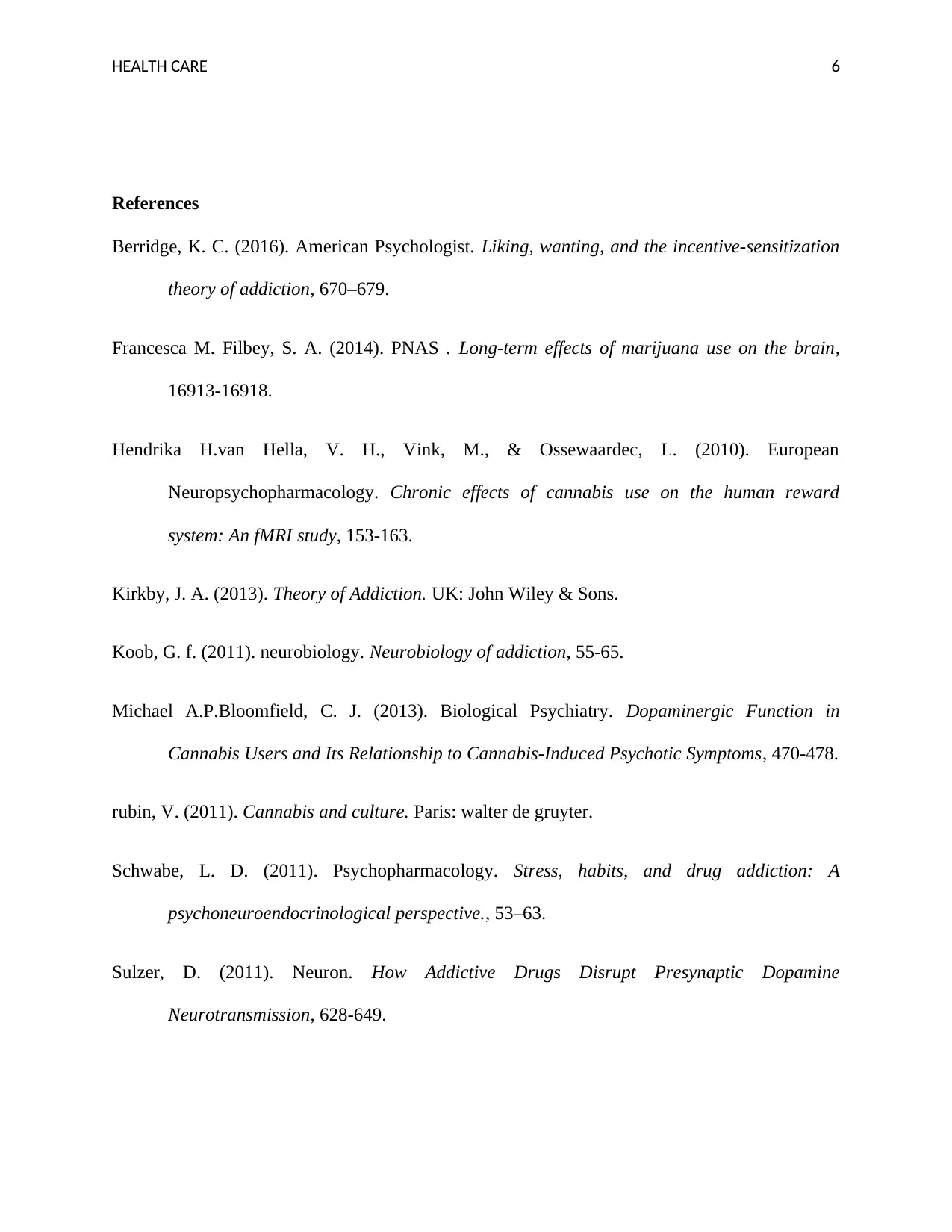
HEALTH CARE 6
References
Berridge, K. C. (2016). American Psychologist. Liking, wanting, and the incentive-sensitization
theory of addiction, 670–679.
Francesca M. Filbey, S. A. (2014). PNAS . Long-term effects of marijuana use on the brain,
16913-16918.
Hendrika H.van Hella, V. H., Vink, M., & Ossewaardec, L. (2010). European
Neuropsychopharmacology. Chronic effects of cannabis use on the human reward
system: An fMRI study, 153-163.
Kirkby, J. A. (2013). Theory of Addiction. UK: John Wiley & Sons.
Koob, G. f. (2011). neurobiology. Neurobiology of addiction, 55-65.
Michael A.P.Bloomfield, C. J. (2013). Biological Psychiatry. Dopaminergic Function in
Cannabis Users and Its Relationship to Cannabis-Induced Psychotic Symptoms, 470-478.
rubin, V. (2011). Cannabis and culture. Paris: walter de gruyter.
Schwabe, L. D. (2011). Psychopharmacology. Stress, habits, and drug addiction: A
psychoneuroendocrinological perspective., 53–63.
Sulzer, D. (2011). Neuron. How Addictive Drugs Disrupt Presynaptic Dopamine
Neurotransmission, 628-649.
References
Berridge, K. C. (2016). American Psychologist. Liking, wanting, and the incentive-sensitization
theory of addiction, 670–679.
Francesca M. Filbey, S. A. (2014). PNAS . Long-term effects of marijuana use on the brain,
16913-16918.
Hendrika H.van Hella, V. H., Vink, M., & Ossewaardec, L. (2010). European
Neuropsychopharmacology. Chronic effects of cannabis use on the human reward
system: An fMRI study, 153-163.
Kirkby, J. A. (2013). Theory of Addiction. UK: John Wiley & Sons.
Koob, G. f. (2011). neurobiology. Neurobiology of addiction, 55-65.
Michael A.P.Bloomfield, C. J. (2013). Biological Psychiatry. Dopaminergic Function in
Cannabis Users and Its Relationship to Cannabis-Induced Psychotic Symptoms, 470-478.
rubin, V. (2011). Cannabis and culture. Paris: walter de gruyter.
Schwabe, L. D. (2011). Psychopharmacology. Stress, habits, and drug addiction: A
psychoneuroendocrinological perspective., 53–63.
Sulzer, D. (2011). Neuron. How Addictive Drugs Disrupt Presynaptic Dopamine
Neurotransmission, 628-649.
Paraphrase This Document
Need a fresh take? Get an instant paraphrase of this document with our AI Paraphraser

HEALTH CARE 7
Vaidya, J. G., Block, r. I., & O'leary, D. S. (2012). Neuropsychopharmacology volume. Effects of
Chronic Marijuana Use on Brain Activity During Monetary Decision-Making, 618-629.
Vaidya, J. G., Block, r. I., & O'leary, D. S. (2012). Neuropsychopharmacology volume. Effects of
Chronic Marijuana Use on Brain Activity During Monetary Decision-Making, 618-629.
1 out of 8
Related Documents
Your All-in-One AI-Powered Toolkit for Academic Success.
+13062052269
info@desklib.com
Available 24*7 on WhatsApp / Email
![[object Object]](/_next/static/media/star-bottom.7253800d.svg)
Unlock your academic potential
Copyright © 2020–2025 A2Z Services. All Rights Reserved. Developed and managed by ZUCOL.




